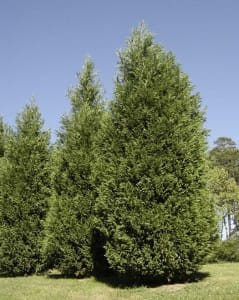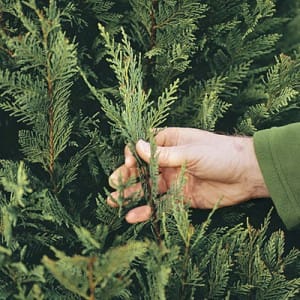Source(s): Jacob G Price
 Leyland cypress trees are widely sold and planted in landscapes throughout the Southeast. The pyramidal, fast-growing trees make a nice screen or specimen plant. Functional life of the tree in the southeast is usually less than 20 years.
Leyland cypress trees are widely sold and planted in landscapes throughout the Southeast. The pyramidal, fast-growing trees make a nice screen or specimen plant. Functional life of the tree in the southeast is usually less than 20 years.
Planting Location
Grows up to three feet per year in fertile well-drained soils but adaptable to most soil types. Place in full sun for best growth. Tolerant to salt spray. More susceptible to insect and disease problems when stressed by drought or other factors.
Insects/Controls
Black Twig Borers, (Ambrosia beetles), can bore into pencil sized limbs and kill the ends of limbs. When first noticed, usually in the spring, they should be pruned out and destroyed. If necessary, preventive barrier sprays such as Pyrethroids and permethrins can be used. Scout the trees in late spring for bagworms and if found, Sevin or Bt products can be used for control. Scale insects and spider mites can damage foliage, but usually are not a major problem. Use bifenthrin or disulfoton for spider mites and cyfluthrin or oils for scale.
Diseases/Controls
Seiridium canker is a serious disease that can kill individual branches and entire trees. Symptoms include yellowing then browning of foliage and numerous oozing cankers on the limbs. Dead foliage is easy to remove with Seiridium infection. Bot cankers are similar, but dead foliage does not fall off easily. Fungicides will not help Seiridium and Bot canker. Pruning affected branches and making sure trees have adequate water help them overcome Seiridium and Bot canker.
Cercosporium, more common in nurseries than landscapes, is a foliar disease that affects the lower branches of newly planted Leylands. Fungicides such as Mancozeb, Daconil, and copper fungicides can control Cercosporium.
Center Publication Number: 70
- Growing Asparagus: A Luxury Vegetable - September 24, 2013
- Frizzle Top in Sago Palms - September 24, 2013
- Growing Onions in the Home Garden - September 24, 2013